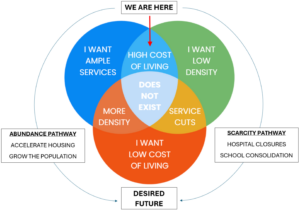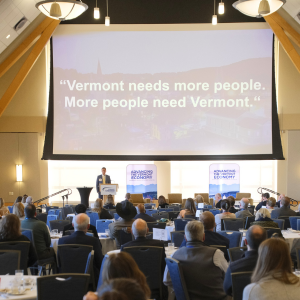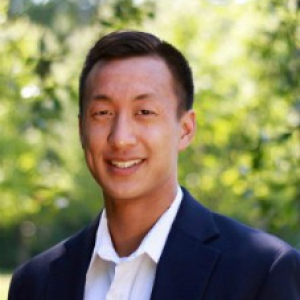Written by Amanda Van Vranken
An Unbalanced Equation
Chances are, you’ve heard about Vermont’s workforce gap. Simply put, the state’s supply of workers isn’t meeting the demand for existing and future jobs. The economy suffers when this workforce equation is out of balance. This is being experienced in real-time by employers that have multiple job vacancies and by consumers who may find it difficult to access goods and services.
Vermont’s population only grew 2.8% over the last decade compared to 4.1% in the Northeast and 7.4% overall across the United States. Over the same time, the age composition of Vermont’s population shifted significantly, with the 65+ age group growing faster than any other cohort.
 Source: US Census Bureau data compiled by USAFacts
Source: US Census Bureau data compiled by USAFacts
Previous work by the Vermont Futures Project in 2017 estimated annual total workforce demand to be nearly 19,000 new workers, with over 11,000 due to annual retirements. The COVID-19 pandemic accelerated the projected rate of retirement, adding even more pressure to the workforce shortage. As older Vermonters transition to retirement, more young professionals are needed to fill an increasing number of available jobs. With unemployment consistently below 3% in 2022, it’s abundantly clear that there simply aren’t enough people in Vermont to meet the workforce demand. A single solution won’t fix this problem, so it’s important to understand the potential impact of proposed strategies. The question now is, “What are ways to rebalance the equation?”
What is Vermont’s Supply of Young Talent?
High school and college graduates are a crucial part of the workforce equation when considering how to resupply the workforce. Vermont has had about 5,300 high school students graduate in each of the past three years. Vermont Agency of Education estimate that sixty percent of those students will enroll in higher education within 16 months of graduation. The other forty percent, approximately 2,100 graduates, are poised to join the job market.
Vermont’s collection of nineteen colleges, universities, and technical/training programs host an average of 50,000 students a year, 10,000 of which graduate with degrees and certificates each spring. An estimated 70% of these graduates are from out of state, underlining the important role post-secondary education institutions have in importing young talent.
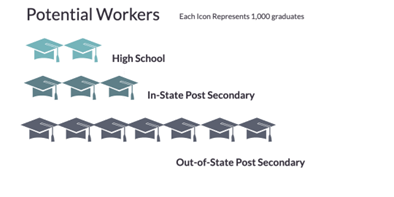
If 100% of these high school and college students stayed in the state post-graduation, roughly 12,000 young professionals would be added to the workforce which would offset the estimated 11,375 annual retirees. Still, we would fall short of the roughly 19,000 new workers needed each year. However 57% of our college graduates leave Vermont which ranks dead last nationally. Grads on the Go, a recent working paper on the migration patterns of college students, shares that nationally about 50% of recent college grads are living and working in the metro area nearest the institution they attended. Increasing retention of college graduates could be a goal for Vermont to aim for. Creative approaches that play to our strengths could increase the percentage of early talent retained in our state.
Attracting & Retaining Young People
Statewide strategies are focusing on ways to attract and retain young workers from Vermont AND out of state. This includes tailoring education and training programs to meet current industry needs. Examples include The McClure Foundation’s annual Most Promising Jobs Report which matches educational attainment to the growing industries paying above the state median wage. The Vermont Technology Alliance is focused on meeting job demands in the tech sector, and post-secondary education focuses on internships, service learning, and apprenticeships to connect students to workplace opportunities across the state. These strategies are geared towards increasing the efficiency of attraction and retention for existing opportunities.
Also worth exploring is how the state might expand opportunities by attracting businesses to benefit from the skills and expertise of our college graduates. Currently, only 30% of jobs in Vermont require a Bachelor’s degree or higher. For comparison, over 43% of the Washington D.C. metro area and 39% of Boston metro area jobs require a Bachelor’s degree or higher. According to post-graduation migration data, these are two of the top locations that Vermont college graduates are leaving for. The University of Vermont awards degrees to an average of 3,500 students a year. These graduates bring valuable career competencies to today’s global marketplace and have skills to contribute to diverse industry sectors such as health sciences, financial services, engineering, tech, food systems, and clean energy. The University of Vermont’s Career Outcomes data showed 43 % of student respondents (in and out-of-state combined) chose to stay in Vermont post-graduation. Increasing the number of job opportunities that align with the skills and qualifications of recent grads through business growth could lead to higher rates of retention.
Vermont has an opportunity to shift from brain drain, to being one of the most attractive states for young professionals to live and work. In a recent report by education research firm Scholaroo, factors such as affordability, social environment, health, safety, and quality of life were ranked for each of the 50 states, and Vermont placed in the top 10 states for Millennials to live. This news is hopeful because the in-migration of young professionals must play a key role in balancing the current workforce equation.
What are your thoughts on how to attract and retain early professionals in the state of Vermont?
What industry solutions could Vermont benefit from to capitalize on the skills and talents of our graduates?
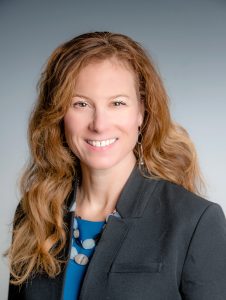
Amanda Van Vranken of Hinesburg, VT, is the Assistant Director for Employer Partnerships at the University of Vermont Career Center. She connects local, regional, and national employers to students and alums seeking internships and employment. Through a variety of recruiting resources and campus opportunities, organizations can network with early talent who are ready to make a positive contribution to their workplaces.
Email: avanvran@uvm.edu
LinkedIn: https://www.linkedin.com/in/amanda-van-vranken/
